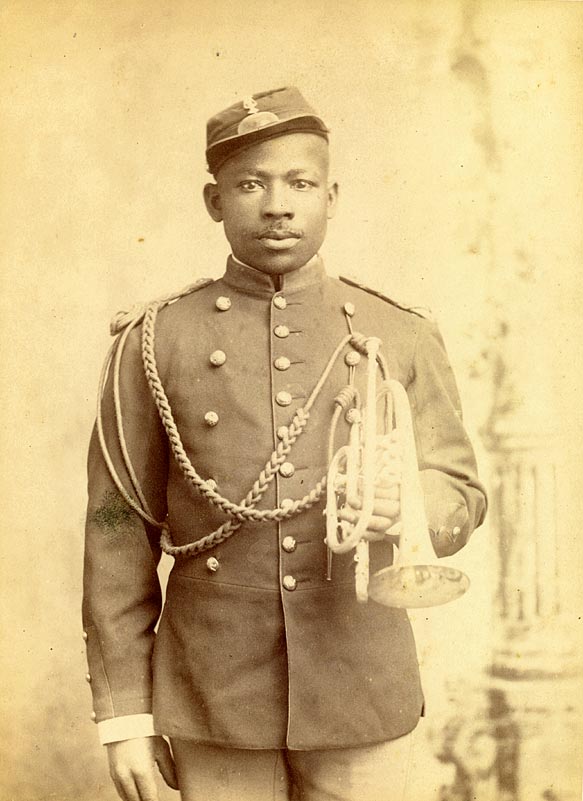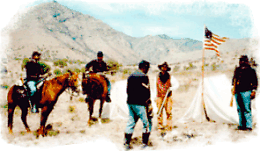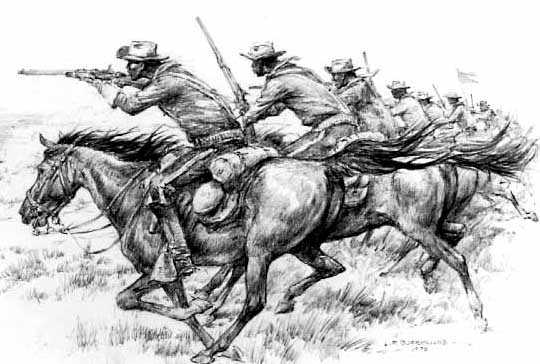|
|
|
|

Who are the Buffalo Soldiers?
African Americans have fought in military conflicts since colonial days. However, the Buffalo Soldiers, comprised of former slaves, freemen and Black Civil War soldiers, were the first to serve during peacetime.
Once the Westward movement had begun, prominent among those blazing treacherous trails of the Wild West were the Buffalo Soldiers of the U.S. Army. These African Americans were charged with and responsible for escorting settlers, cattle herds, and railroad crews. The 9th and 10th Cavalry Regiments also conducted campaigns against American Indian tribes on a western frontier that extended from Montana in the Northwest to Texas, New Mexico, and Arizona in the Southwest. Throughout the era of the Indian Wars, approximately twenty percent of the U.S. Cavalry troopers were Black, and they fought over 177 engagements. The combat prowess, bravery, tenaciousness, and looks on the battlefield, inspired the Indians to call them "Buffalo Soldiers." Many Indians believe the name symbolized the Native American's respect for the Buffalo Soldiers' bravery and valor. Buffalo Soldiers, down through the years, have worn the name with pride.
Buffalo Soldiers participated in many other military campaigns: The Spanish American War, The Philippine Insurrection, The Mexican Expedition, World War I, World War II, and the Korean Police Action.
Much have changed since the days of the Buffalo Soldiers, including the integration of all military servicemen and women. However, the story of the Buffalo Soldiers remain one of unsurpassed courage and patriotism, and will be forever a significant part of the history of America.
African Americans have fought with distinction in all of this country's military engagements. However, some of their most notable contributions and sacrifices came during the Civil War. During that conflict, more than 180,000 African Americans wore the Union Army blue. Another 30,000 served in the Navy, and 200,000 served as workers on labor, engineering, hospital and other military support projects. More than 33,000 of these gallant soldiers gave their lives for the sake of freedom and their country.
Shortly after the Civil War, Congress authorized the formation of the 9th and 10th Cavalry and the 38th, 39th, 40th, and 41st Infantry Regiments: Six all Black peacetime units. Later the four infantry regiments were merged into the 24th and 25th Infantries.
In countless skirmishes and firefights, the troopers won the respect of the Plains warriors who named "Buffalo Soldiers." African Americans accepted the badge of honor and wore it proudly.
At least 18 Medals of Honor were presented to Buffalo Soldiers during the Western Campaigns. Similarly, 23 African Americans received the nation's highest military award during the Civil War.
Buffalo Soldiers in the Guadalupe Mountains
The casual history novice passing quickly through Guadalupe Mountains National Park learns about the role ranching played in these mountains, that the original route of the Butterfield Overland Mail Stage ran through Guadalupe Pass for a brief time, and that this was the last Apache stronghold in Texas. But skirmishes between Mescalero Apache and Black troopers is less common knowledge. Yet hikers along the Foothills Trail walk through an area which was once the sight of a large cavalry encampment. To the untrained eye, there is no obvious evidence of the camp, but the close proximity to lower Pine Springs made it a valuable site to the military. An old rifle pit was discovered near this site. Another camp location at Manzanita Spring was briefly referred to as "Camp Safford" for Lt. Safford who died there of acute dysentery.

Despite some pleasant asides, military patrols in and around the Guadalupe Mountains were long and arduous, food was limited in variety, sometimes quantity, and almost always palatability - and water was scarce! In fact, many of the patrols made by the Buffalo Soldiers were essentially mapping expeditions for viable water sources and to record significant geographic features. This information would later prove to be useful in the fight against the elusive Warm Springs Apache Chief, Victorio.
Victorio's last skirmish with Colonel Grierson and the 10th Cavalry occurred in August 1880, only 40 miles south of the Guadalupes in the Sierra Diablo Mountains, at a place called Rattlesnake Springs.
Desperate for water, the Apache Chief made two attacks on the cavalry before being repelled. Grierson had cleverly cut the Apaches off from this critical resource; outguessing and beating Victorio's band to the springs in a marathon 65 mile ride through the harshest of country within 21 hours on horseback and wagons. Victorio was forced to retreat into Mexico, where he and his band were later killed by Mexican troops. Their demise was in and of itself a sad passage in the history of people indigenous to this country.
Little has been specifically written about the skirmishes between the Apache and the Buffalo Soldiers in the Guadalupe Mountains, but their spirits ride on the wind, patiently awaiting the long overdue recognition that they deserve in the annals of American history.
A Tribute
In February each year, Guadalupe Mountains National Park honors the brave men of the 9th and 10th Cavalry Regiments by displaying artwork depicting the Buffalo Soldiers in the auditorium of the Headquarters Visitor Center. In July, 1997, Texas Parks & Wildlife employees put on a living history demonstration of the Buffalo Soldiers at Frijole Ranch, near the old military camp site. Check the Special Events Page for future living history demonstrations.
For further reading refer to The Buffalo Soldiers by William H. Leckie. This book, a narrative of the Negro Cavalry in the West, remains one of the best sources on the subject.
In celebration of Black History Month 2005 , Wal-Mart Stores, Inc. is sponsoring a multi-dimensional educational program honoring the Buffalo Soldiers , African Americans who served in the segregated units of the American military from 1866 to 1951. The program heralds under-recognized heroes of African American history who have contributed in profound and lasting ways to American life.
Celebrate the Buffalo Soldier Legacy and Honor Our African American Military Heroes

|
|
|
|
|
|
 Military Chronology
Military Chronology
